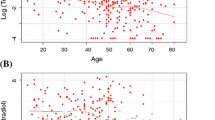Abstract.
The aim of this study was to clarify the relationship between endogenous estrogen, sex hormone-binding globulin (SHBG), and bone loss in pre-, peri-, and postmenopausal female residents of Taiji, a rural Japanese community. From a list of inhabitants aged 40 to 79 years, 200 participants—50 women in each of four age decades—were randomly selected, and baseline bone mineral density (BMD) at the lumbar spine and proximal femur were measured by dual-energy X-ray absorptiometry in 1993. Total estradiol (total E2) and SHBG were measured, and SHBG-unbound E2 (UBE2) was calculated using SHBG and the percent SHBG-unbound fraction ratio. BMD was measured again 3 years later, in 1996. Participants with ovariectomy or hysterectomy were excluded, and the remaining participants were categorized into four groups: premenopausal (n= 38), perimenopausal (n= 14), postmenopausal group 1 (5 years or less since menopause; n= 18), and postmenopausal group 2 (6 years or more since menopause; n= 74). The mean value of total E2 was highest in the premenopausal group (49.1 pg/ml), followed by the perimenopausal group (26.4 pg/ml), and the postmenopausal groups (0.83 pg/ml in postmenopausal group 1 and 0.96 pg/ml in postmenopausal group 2). The means for UBE2 showed the same pattern across the groups. After the multiple regression analysis of BMD at follow-up and endogenous estrogens, in premenopausal women, there were no significant associations between BMD at follow-up and serum total E2 and UBE2. In perimenopausal women, however, serum total E2 and UBE2 were significantly correlated with trochanteric BMD at follow-up (P < 0.05); and in postmenopausal group 2, they were significantly correlated with lumbar spine and Ward's triangle BMD at follow-up (P < 0.001 at lumbar spine, P < 0.05 at Ward's triangle). Concerning the association between BMD at follow-up and SHBG, in the premenopausal group, serum levels of SHBG were negatively correlated with BMD at the femoral neck (P < 0.05). In regard to partial regression coefficients for the change rates of BMD over 3 years and serum estrogens and SHBG concentrations, in perimenopausal women, UBE2 was correlated with the change rate of BMD at Ward's triangle (P < 0.05), and in postmenopausal group 1, serum levels of SHBG were significantly negatively related to change in BMD at the trochanter (P < 0.01). No other relationships with change in BMD were observed at any sites. These findings suggest that serum E2, UBE2, and SHBG levels differentially predict BMD levels in groups of differing menstrual status. It would, however, be difficult to predict bone loss in middle-aged and elderly Japanese women over a 3-year period using these indices alone.
Similar content being viewed by others
Author information
Authors and Affiliations
Additional information
Received: November 29, 2001 / Accepted: February 28, 2002
About this article
Cite this article
Yoshimura, N., Kasamatsu, T., Sakata, K. et al. The relationship between endogenous estrogen, sex hormone-binding globulin, and bone loss in female residents of a rural Japanese community: the Taiji Study. J Bone Miner Metab 20, 303–310 (2002). https://doi.org/10.1007/s007740200044
Issue Date:
DOI: https://doi.org/10.1007/s007740200044




